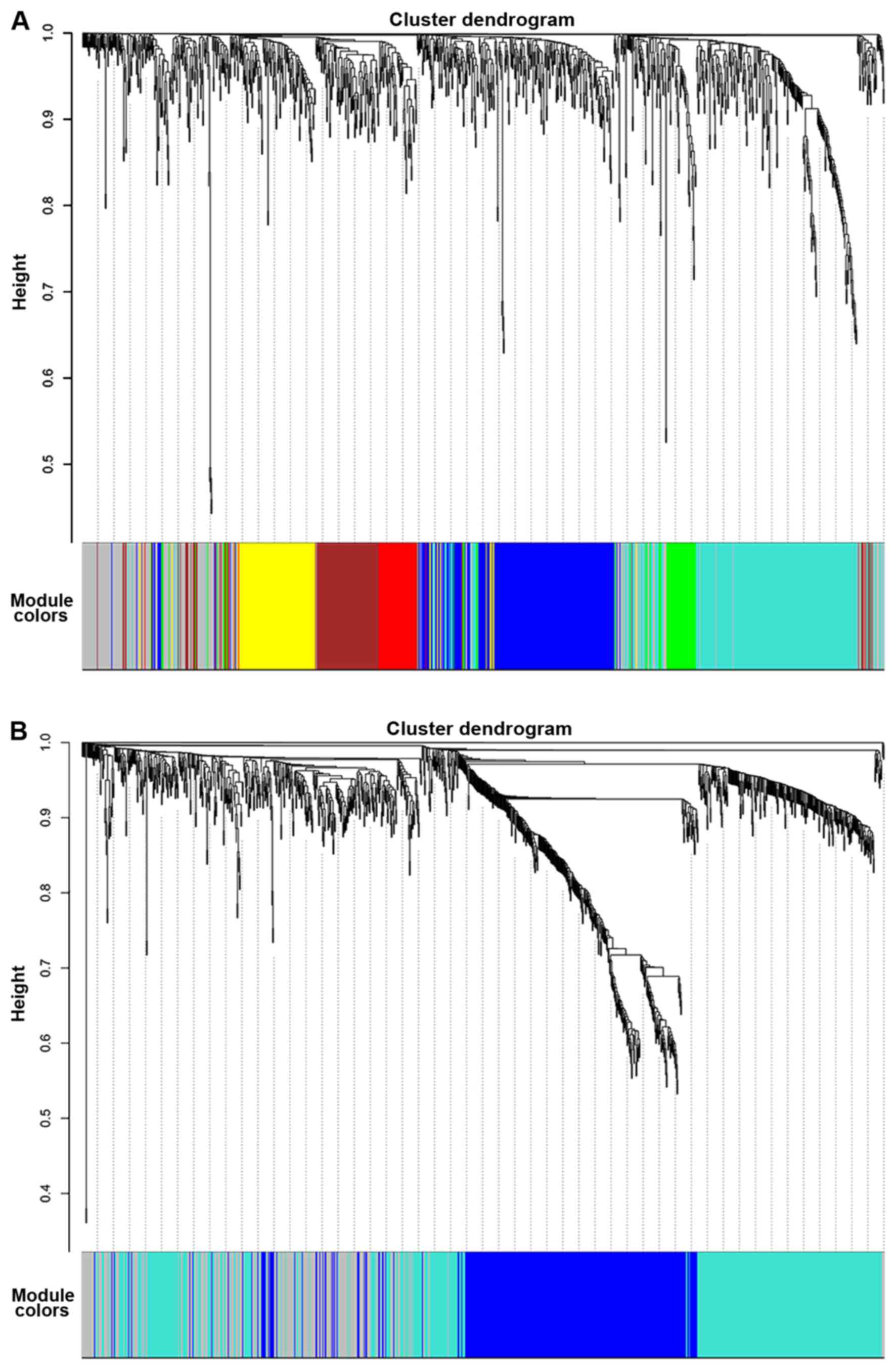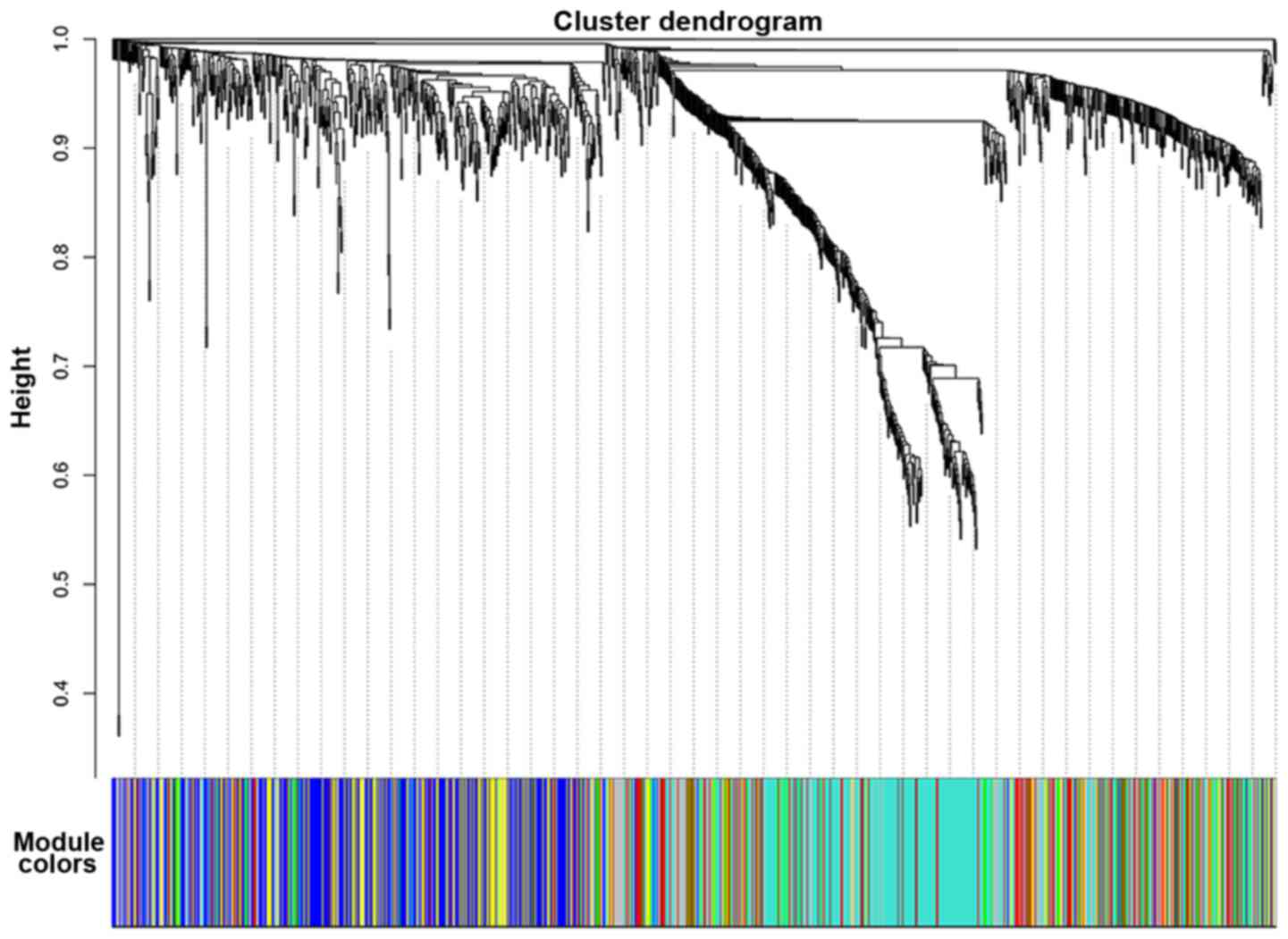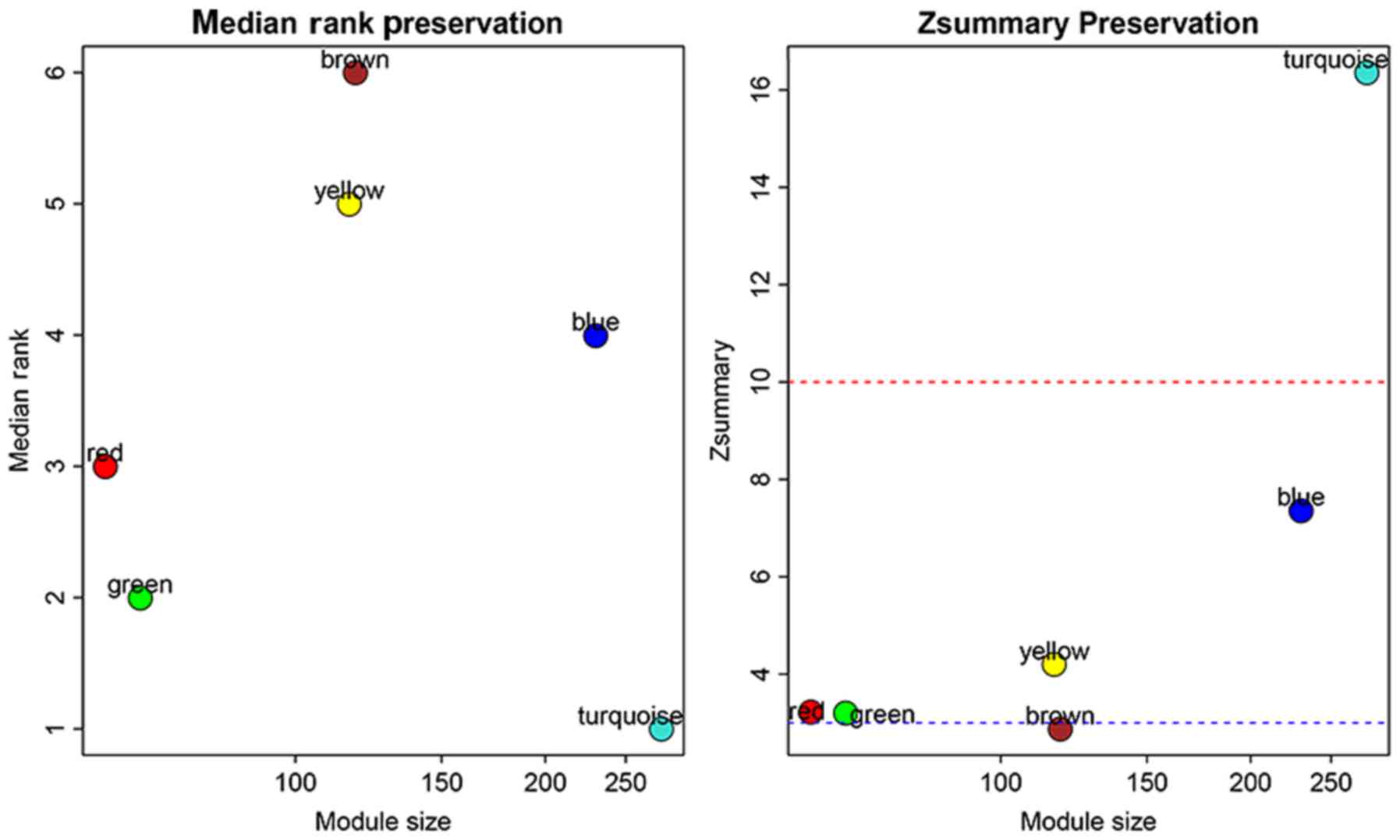|
1
|
Kitahara CM and Sosa JA: The changing
incidence of thyroid cancer. Nat Rev Endocrinol. 12:646–653. 2016.
View Article : Google Scholar : PubMed/NCBI
|
|
2
|
Schneider DF and Chen H: New developments
in the diagnosis and treatment of thyroid cancer. CA Cancer J Clin.
63:374–394. 2013. View Article : Google Scholar : PubMed/NCBI
|
|
3
|
Cancer Genome Atlas Research Network, .
Integrated genomic characterization of papillary thyroid carcinoma.
Cell. 159:676–690. 2014. View Article : Google Scholar : PubMed/NCBI
|
|
4
|
Ye L, Zhou X, Huang F, Wang W, Qi Y, Xu H,
Yang S, Shen L, Fei X, Xie J, et al: The genetic landscape of
benign thyroid nodules revealed by whole exome and transcriptome
sequencing. Nat Commun. 8:155332017. View Article : Google Scholar : PubMed/NCBI
|
|
5
|
Hsiao SJ and Nikiforov YE: Molecular
approaches to thyroid cancer diagnosis. Endocr Relat Cancer.
21:T301–T313. 2014.PubMed/NCBI
|
|
6
|
Xing M, Haugen BR and Schlumberger M:
Progress in molecular-based management of differentiated thyroid
cancer. Lancet. 381:1058–1069. 2013. View Article : Google Scholar : PubMed/NCBI
|
|
7
|
Eichler EE, Flint J, Gibson G, Kong A,
Leal SM, Moore JH and Nadeau JH: Missing heritability and
strategies for finding the underlying causes of complex disease.
Nat Rev Genet. 11:446–450. 2010. View
Article : Google Scholar : PubMed/NCBI
|
|
8
|
Langfelder P and Horvath S: WGCNA: An R
package for weighted correlation network analysis. BMC
Bioinformatics. 9:5592008. View Article : Google Scholar : PubMed/NCBI
|
|
9
|
Liu W and Ye H: Co-expression network
analysis identifies transcriptional modules in the mouse liver. Mol
Genet Genomics. 289:847–853. 2014. View Article : Google Scholar : PubMed/NCBI
|
|
10
|
Chen YC, Guo YF, He H, Lin X, Wang XF,
Zhou R, Li WT, Pan DY, Shen J and Deng HW: Integrative analysis of
genomics and transcriptome data to identify potential functional
genes of BMDs in females. J Bone Miner Res. 31:1041–1049. 2016.
View Article : Google Scholar : PubMed/NCBI
|
|
11
|
Kogelman LJ, Cirera S, Zhernakova DV,
Fredholm M, Franke L and Kadarmideen HN: Identification of
co-expression gene networks, regulatory genes and pathways for
obesity based on adipose tissue RNA sequencing in a porcine model.
BMC Med Genomics. 7:572014. View Article : Google Scholar : PubMed/NCBI
|
|
12
|
Plaisier CL, Horvath S, Huertas-Vazquez A,
Cruz-Bautista I, Herrera MF, Tusie-Luna T, Aguilar-Salinas C and
Pajukanta P: A systems genetics approach implicates USF1, FADS3,
and other causal candidate genes for familial combined
hyperlipidemia. PLoS Genet. 5:e10006422009. View Article : Google Scholar : PubMed/NCBI
|
|
13
|
Wang B, He L, Miao W, Wu G, Jiang H, Wu Y,
Qu J and Li M: Identification of key genes associated with
Schmid-type metaphyseal chondrodysplasia based on microarray data.
Int J Mol Med. 39:1428–1436. 2017. View Article : Google Scholar : PubMed/NCBI
|
|
14
|
Riquelme Medina I and Lubovac-Pilav Z:
Gene Co-expression network analysis for identifying modules and
functionally enriched pathways in type 1 diabetes. PLoS One.
11:e01560062016. View Article : Google Scholar : PubMed/NCBI
|
|
15
|
Tomás G, Tarabichi M, Gacquer D, Hébrant
A, Dom G, Dumont JE, Keutgen X, Fahey TJ III, Maenhaut C and
Detours V: A general method to derive robust organ-specific gene
expression-based differentiation indices: Application to thyroid
cancer diagnostic. Oncogene. 31:4490–4498. 2012. View Article : Google Scholar : PubMed/NCBI
|
|
16
|
Gautier L, Cope L, Bolstad BM and Irizarry
RA: Affy-analysis of Affymetrix GeneChip data at the probe level.
Bioinformatics. 20:307–315. 2004. View Article : Google Scholar : PubMed/NCBI
|
|
17
|
Smyth GK: Linear models and empirical
bayes methods for assessing differential expression in microarray
experiments. Stat Appl Genet Mol Biol. 3:Article 3. 2004.
View Article : Google Scholar : PubMed/NCBI
|
|
18
|
Zhang B and Horvath S: A general framework
for weighted gene co-expression network analysis. Stat Appl Genet
Mol Biol. 4:Article17. 2005. View Article : Google Scholar : PubMed/NCBI
|
|
19
|
Langfelder P, Luo R, Oldham MC and Horvath
S: Is my network module preserved and reproducible? PLoS Comput
Biol. 7:e10010572011. View Article : Google Scholar : PubMed/NCBI
|
|
20
|
Huang DW, Sherman BT, Tan Q, Collins JR,
Alvord WG, Roayaei J, Stephens R, Baseler MW, Lane HC and Lempicki
RA: The DAVID gene functional classification tool: A novel
biological module-centric algorithm to functionally analyze large
gene lists. Genome Biol. 8:R1832007. View Article : Google Scholar : PubMed/NCBI
|
|
21
|
Herwig R, Hardt C, Lienhard M and Kamburov
A: Analyzing and interpreting genome data at the network level with
ConsensusPathDB. Nat Protoc. 11:1889–1907. 2016. View Article : Google Scholar : PubMed/NCBI
|
|
22
|
Gilbert-Sirieix M, Makoukji J, Kimura S,
Talbot M, Caillou B, Massaad C and Massaad-Massade L: Wnt/β-catenin
signaling pathway is a direct enhancer of thyroid transcription
factor-1 in human papillary thyroid carcinoma cells. PLoS One.
6:e222802011. View Article : Google Scholar : PubMed/NCBI
|
|
23
|
Ishigaki K, Namba H, Nakashima M, Nakayama
T, Mitsutake N, Hayashi T, Maeda S, Ichinose M, Kanematsu T and
Yamashita S: Aberrant localization of beta-catenin correlates with
overexpression of its target gene in human papillary thyroid
cancer. J Clin Endocrinol Metab. 87:3433–3440. 2002. View Article : Google Scholar : PubMed/NCBI
|
|
24
|
Fluge Ø, Bruland O, Akslen LA, Lillehaug
JR and Varhaug JE: Gene expression in poorly differentiated
papillary thyroid carcinomas. Thyroid. 16:161–175. 2006. View Article : Google Scholar : PubMed/NCBI
|
|
25
|
Qiu J, Zhang W, Xia Q, Liu F, Li L, Zhao
S, Gao X, Zang C, Ge R and Sun Y: RNA sequencing identifies crucial
genes in papillary thyroid carcinoma (PTC) progression. Exp Mol
Pathol. 100:151–159. 2016. View Article : Google Scholar : PubMed/NCBI
|
|
26
|
Qu T, Li YP, Li XH and Chen Y:
Identification of potential biomarkers and drugs for papillary
thyroid cancer based on gene expression profile analysis. Mol Med
Rep. 14:5041–5048. 2016. View Article : Google Scholar : PubMed/NCBI
|
|
27
|
Zhu X, Yao J and Tian W: Microarray
technology to investigate genes associated with papillary thyroid
carcinoma. Mol Med Rep. 11:3729–3733. 2015. View Article : Google Scholar : PubMed/NCBI
|
|
28
|
Hucz J, Kowalska M, Jarzab M and Wiench M:
Gene expression of metalloproteinase 11, claudin 1 and selected
adhesion related genes in papillary thyroid cancer. Endokrynol Pol.
57 Suppl A:18–25. 2006.(In Polish). PubMed/NCBI
|
|
29
|
Jarzab B, Wiench M, Fujarewicz K, Simek K,
Jarzab M, Oczko-Wojciechowska M, Wloch J, Czarniecka A, Chmielik E,
Lange D, et al: Gene expression profile of papillary thyroid
cancer: Sources of variability and diagnostic implications. Cancer
Res. 65:1587–1597. 2005. View Article : Google Scholar : PubMed/NCBI
|
|
30
|
Kim HS, Kim DH, Kim JY, Jeoung NH, Lee IK,
Bong JG and Jung ED: Microarray analysis of papillary thyroid
cancers in Korean. Korean J Intern Med. 25:399–407. 2010.
View Article : Google Scholar : PubMed/NCBI
|
|
31
|
Zhang H, Cai Y, Zheng L, Zhang Z, Lin X
and Jiang N: Long noncoding RNA NEAT1 regulate papillary thyroid
cancer progression by modulating miR-129-5p/KLK7 expression. J Cell
Physiol. 233:6638–6648. 2018. View Article : Google Scholar : PubMed/NCBI
|
|
32
|
Lamba Saini M, Weynand B, Rahier J, Mourad
M, Hamoir M and Marbaix E: Cyclin D1 in well differentiated thyroid
tumour of uncertain malignant potential. Diagn Pathol. 10:322015.
View Article : Google Scholar : PubMed/NCBI
|
|
33
|
Lantsov D, Meirmanov S, Nakashima M, Kondo
H, Saenko V, Naruke Y, Namba H, Ito M, Abrosimov A, Lushnikov E, et
al: Cyclin D1 overexpression in thyroid papillary microcarcinoma:
Its association with tumour size and aberrant beta-catenin
expression. Histopathology. 47:248–256. 2005. View Article : Google Scholar : PubMed/NCBI
|
|
34
|
Guo D, Yuan Z, Ru J, Gu X, Zhang W, Mao F,
Ouyang H, Wu K, Liu Y and Liu C: A spatiotemporal requirement for
prickle 1-mediated PCP signaling in eyelid morphogenesis and
homeostasis. Invest Ophthalmol Vis Sci. 59:952–966. 2018.
View Article : Google Scholar : PubMed/NCBI
|
|
35
|
Dyberg C, Papachristou P, Haug BH,
Lagercrantz H, Kogner P, Ringstedt T, Wickström M and Johnsen JI:
Planar cell polarity gene expression correlates with tumor cell
viability and prognostic outcome in neuroblastoma. BMC Cancer.
16:2592016. View Article : Google Scholar : PubMed/NCBI
|
|
36
|
Vander Vorst K, Hatakeyama J, Berg A, Lee
H and Carraway KL III: Cellular and molecular mechanisms underlying
planar cell polarity pathway contributions to cancer malignancy.
Semin Cell Dev Biol. Nov 4–2017.(Epub ahead of print).
|
|
37
|
Katoh M: WNT/PCP signaling pathway and
human cancer (review). Oncol Rep. 14:1583–1588. 2005.PubMed/NCBI
|
|
38
|
Lee JU, Huang S, Lee MH, Lee SE, Ryu MJ,
Kim SJ, Kim YK, Kim SY, Joung KH, Kim JM, et al: Dual specificity
phosphatase 6 as a predictor of invasiveness in papillary thyroid
cancer. Eur J Endocrinol. 167:93–101. 2012. View Article : Google Scholar : PubMed/NCBI
|
|
39
|
Degl'Innocenti D, Romeo P, Tarantino E,
Sensi M, Cassinelli G, Catalano V, Lanzi C, Perrone F, Pilotti S,
Seregni E, et al: DUSP6/MKP3 is overexpressed in papillary and
poorly differentiated thyroid carcinoma and contributes to
neoplastic properties of thyroid cancer cells. Endocr Relat Cancer.
20:23–37. 2013. View Article : Google Scholar : PubMed/NCBI
|
|
40
|
Gu Y, Li D, Luo Q, Wei C, Song H, Hua K,
Song J, Luo Y, Li X and Fang L: MicroRNA-145 inhibits human
papillary cancer TPC1 cell proliferation by targeting DUSP6. Int J
Clin Exp Med. 8:8590–8598. 2015.PubMed/NCBI
|
|
41
|
Kedage V, Selvaraj N, Nicholas TR, Budka
JA, Plotnik JP, Jerde TJ and Hollenhorst PC: An interaction with
ewing's sarcoma breakpoint protein EWS defines a specific oncogenic
mechanism of ETS factors rearranged in prostate cancer. Cell Rep.
17:1289–1301. 2016. View Article : Google Scholar : PubMed/NCBI
|
|
42
|
Xiao J, Yang S, Shen P, Wang Y, Sun H, Ji
F and Zhou D: Phosphorylation of ETV4 at Ser73 by ERK kinase could
block ETV4 ubiquitination degradation in colorectal cancer. Biochem
Biophys Res Commun. 486:1062–1068. 2017. View Article : Google Scholar : PubMed/NCBI
|
|
43
|
Qi M, Liu Z, Shen C, Wang L, Zeng J, Wang
C, Li C, Fu W, Sun Y and Han B: Overexpression of ETV4 is
associated with poor prognosis in prostate cancer: Involvement of
uPA/uPAR and MMPs. Tumour Biol. 36:3565–3572. 2015. View Article : Google Scholar : PubMed/NCBI
|
|
44
|
Pedrola N, Devis L, Llauradó M, Campoy I,
Martinez-Garcia E, Garcia M, Muinelo-Romay L, Alonso-Alconada L,
Abal M, Alameda F, et al: Nidogen 1 and Nuclear Protein 1: Novel
targets of ETV5 transcription factor involved in endometrial cancer
invasion. Clin Exp Metastasis. 32:467–478. 2015. View Article : Google Scholar : PubMed/NCBI
|
|
45
|
Llauradó M, Majem B, Castellví J, Cabrera
S, Gil-Moreno A, Reventós J and Ruiz A: Analysis of gene expression
regulated by the ETV5 transcription factor in OV90 ovarian cancer
cells identifies FOXM1 overexpression in ovarian cancer. Mol Cancer
Res. 10:914–924. 2012. View Article : Google Scholar : PubMed/NCBI
|

















